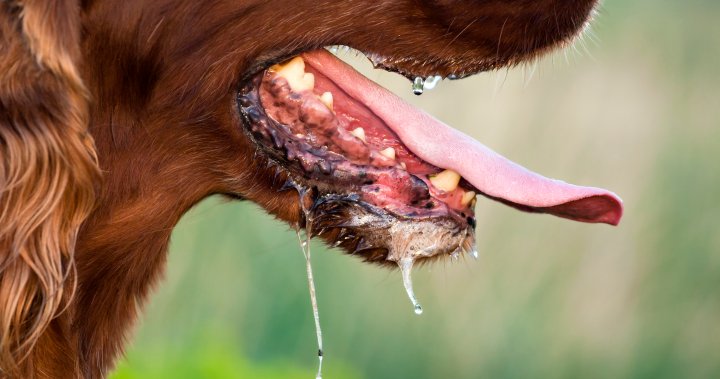While Health Minister Mark Holland pushes to exempt Canada from stricter United States dog regulations at the border due to our low rabies risk, experts warn the disease can still pose a serious domestic threat. If left untreated, rabies is 100 per cent fatal.
Speaking to the media on Wednesday, Holland described Canada as a “rabies-free country.” However, Dr. Isaac Bogoch, an infectious diseases specialist, explained rabies cases still occur in Canada and the disease is extremely difficult to eradicate.
“Rabies is a viral infection. We get it from the bite or saliva of other mammals, and in humans, it is universally fatal,” explained infectious diseases specialist Dr. Isaac Bogoch. “I think that is the key message for anyone [if you get infected], you’re not going to survive.”
Since 2000, the number of reported rabies-positive animals in Canada has declined, largely due to control programs, according to Health Canada. However, infections still occur, primarily in bats, skunks, raccoons and foxes. Rabies is also fatal for humans.
But it remains very rare in Canada.

The U.S. Centers for Disease Control and Prevention (CDC) is implementing the new regulations, which means pet owners must then fill out paperwork before their planned visit. The papers, which will be available on the CDC website, will prove that the dog is healthy, has a valid microchip and is vaccinated against the rabies virus.
The federal government is arguing that Canada should be exempt from the rules entirely because there is no dog-maintained rabies virus in this country.
Rabies spreads in the body by travelling through the peripheral nerves from the site of the bite to the brain, where it causes severe inflammation and ultimately leads to neurological symptoms and death if untreated, Bogoch told Global News.
In Canada, since reporting began in 1924, there have been 26 cases of rabies in humans in six provinces and all cases were fatal, Health Canada data shows.
The latest case was in British Columbia in 2019 when a man came into contact with a bat on Vancouver Island. He didn’t show any symptoms until six to eight weeks after. He later died.
“That was the most recent locally acquired case,” Bogoch said. “Also we will see return travellers into Canada who acquired this overseas. And most of the cases acquired overseas are from dog bites. That’s a common cause.”
Due to the risk of rabies transmission through dogs, the U.S. has implemented tighter restrictions on canines entering the country, including those from Canada. The regulations kick in on Aug. 1.
The U.S. Centers for Disease Control and Prevention agency has identified 131 countries as high risk for rabies. Canada isn’t on the list.
The latest health and medical news
emailed to you every Sunday.

Get weekly health news
Receive the latest medical news and health information delivered to you every Sunday.
Because Canada isn’t on the list, the federal government is pushing for an exemption from the rule.
Although rabies is not prevalent in the canine population in Canada, thanks to vaccination strategies, it still exists in dogs, according to Dr. Nicola Schaefer, a staff veterinarian at the Winnipeg Humane Society.

“It definitely exists in dogs in Canada. We see it, but we don’t see it a lot,” she said. “It’s more rural communities and places with less access to veterinary care.”
Despite the risk, there is protection — a rabies vaccination.
The Canadian Veterinarian Medical Association recommends that all dogs get vaccinated against rabies. Even dogs that do not go outside should be vaccinated, the organization said, as rabid bats can gain entry into homes, and rabid wildlife such as skunks and raccoons can enter a fenced yard or obtain access to a home through a screened door.
“We have a very good rabies vaccine and it works,” Schaefer said. “And if your pet is fully vaccinated, then even if it gets bitten by some kind of wildlife, you should still bring it for medical attention. But its risk of coming down with rabies is pretty much zero.”
What to do if an animal bites you?
No matter the animal, Bogoch stressed the importance of getting immediate medical care after a bite.
“If you get bit by any animal, you have to go seek health care. If you can have an animal bite you’ve got to take it very seriously,” he said. “Animal bites can cause lots of different infections. Mammals can transmit rabies, among many other infections. Non-mammals don’t transmit rabies, but can also transmit many infections through the bite.”
And timing is of the essence after a bite, Bogoch added.
This is because once the virus enters the body through a mammal bite, it travels to the nervous system quickly. Once symptoms of rabies appear, the disease is almost always fatal, he said.
“If it’s deemed to be a possible rabies exposure, we would give two types of products. One is a vaccine and one is what’s called rabies immunoglobulin. They are both very, very effective in reducing the risk of clinical rabies,” he said.
Symptoms of rabies usually take about three to eight weeks to develop, according to Health Canada. However, this can also range from several days to many months. Once symptoms appear, death usually occurs within seven to 14 days, the health regulator added.
For rabies to cause an infection, the virus must enter the body and reach the nerve cells. It then travels through the nerves to the spinal cord and brain, where it replicates. From there, the virus spreads back through the nerves to various parts of the body, leading to the symptoms of rabies.
Early symptoms can include fever, tiredness, headaches, anxiety or irritability.
“You might also experience pain, tingling, numbness, or itching around the area where the animal bit, scratched, or licked you. As the virus attacks the central nervous system, symptoms quickly worsen,” Health Canada stated.

Other symptoms that typically follow rabies include hydrophobia, Bogoch said.
“Hydrophobia is where they just cannot drink water. If you put a glass of water in front of them, they just won’t be able to and will have that visceral aversion to water,” he said.
Humans can protect themselves against rabies by getting vaccinated, especially if travelling to a country with a high risk of the disease.
You can check out the full list here.
The federal government recommends rabies vaccines for groups such as people who work with animals, lab workers who handle the virus and individuals who travel to countries that are known for having dogs that carry the disease.
Other ways to reduce your risk of getting rabies are to keep away from sick or dead animals, closely supervise children around animals avoid touching or feeding unknown, stray or wild animals, routinely vaccinate your pets and livestock against rabies, and know the signs of rabies and report an animal that’s acting strangely to your local public health unit.





